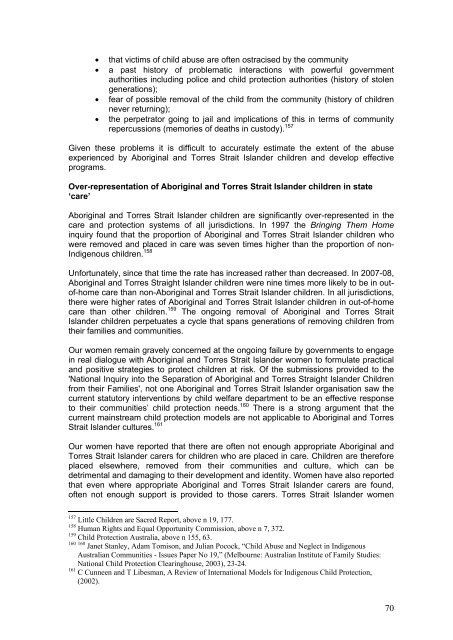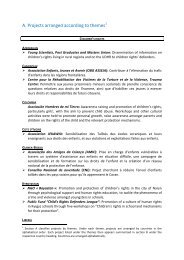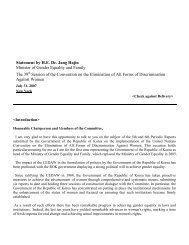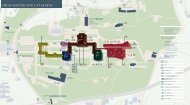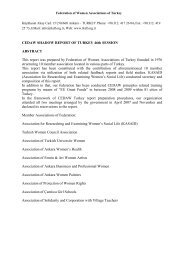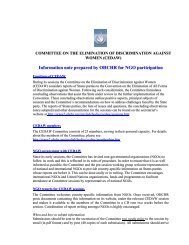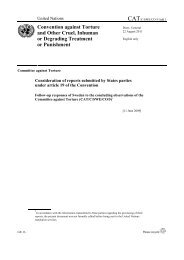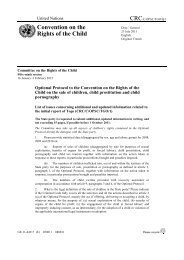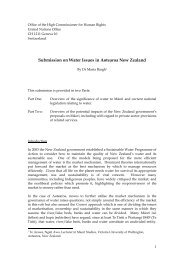Australian Aboriginal and Torres Strait Islander Women's Parallel ...
Australian Aboriginal and Torres Strait Islander Women's Parallel ...
Australian Aboriginal and Torres Strait Islander Women's Parallel ...
You also want an ePaper? Increase the reach of your titles
YUMPU automatically turns print PDFs into web optimized ePapers that Google loves.
• that victims of child abuse are often ostracised by the community• a past history of problematic interactions with powerful governmentauthorities including police <strong>and</strong> child protection authorities (history of stolengenerations);• fear of possible removal of the child from the community (history of childrennever returning);• the perpetrator going to jail <strong>and</strong> implications of this in terms of communityrepercussions (memories of deaths in custody). 157Given these problems it is difficult to accurately estimate the extent of the abuseexperienced by <strong>Aboriginal</strong> <strong>and</strong> <strong>Torres</strong> <strong>Strait</strong> Isl<strong>and</strong>er children <strong>and</strong> develop effectiveprograms.Over-representation of <strong>Aboriginal</strong> <strong>and</strong> <strong>Torres</strong> <strong>Strait</strong> Isl<strong>and</strong>er children in state‘care’<strong>Aboriginal</strong> <strong>and</strong> <strong>Torres</strong> <strong>Strait</strong> Isl<strong>and</strong>er children are significantly over-represented in thecare <strong>and</strong> protection systems of all jurisdictions. In 1997 the Bringing Them Homeinquiry found that the proportion of <strong>Aboriginal</strong> <strong>and</strong> <strong>Torres</strong> <strong>Strait</strong> Isl<strong>and</strong>er children whowere removed <strong>and</strong> placed in care was seven times higher than the proportion of non-Indigenous children. 158Unfortunately, since that time the rate has increased rather than decreased. In 2007-08,<strong>Aboriginal</strong> <strong>and</strong> <strong>Torres</strong> Straight Isl<strong>and</strong>er children were nine times more likely to be in outof-homecare than non-<strong>Aboriginal</strong> <strong>and</strong> <strong>Torres</strong> <strong>Strait</strong> Isl<strong>and</strong>er children. In all jurisdictions,there were higher rates of <strong>Aboriginal</strong> <strong>and</strong> <strong>Torres</strong> <strong>Strait</strong> Isl<strong>and</strong>er children in out-of-homecare than other children. 159 The ongoing removal of <strong>Aboriginal</strong> <strong>and</strong> <strong>Torres</strong> <strong>Strait</strong>Isl<strong>and</strong>er children perpetuates a cycle that spans generations of removing children fromtheir families <strong>and</strong> communities.Our women remain gravely concerned at the ongoing failure by governments to engagein real dialogue with <strong>Aboriginal</strong> <strong>and</strong> <strong>Torres</strong> <strong>Strait</strong> Isl<strong>and</strong>er women to formulate practical<strong>and</strong> positive strategies to protect children at risk. Of the submissions provided to the'National Inquiry into the Separation of <strong>Aboriginal</strong> <strong>and</strong> <strong>Torres</strong> Straight Isl<strong>and</strong>er Childrenfrom their Families', not one <strong>Aboriginal</strong> <strong>and</strong> <strong>Torres</strong> <strong>Strait</strong> Isl<strong>and</strong>er organisation saw thecurrent statutory interventions by child welfare department to be an effective responseto their communities’ child protection needs. 160 There is a strong argument that thecurrent mainstream child protection models are not applicable to <strong>Aboriginal</strong> <strong>and</strong> <strong>Torres</strong><strong>Strait</strong> Isl<strong>and</strong>er cultures. 161Our women have reported that there are often not enough appropriate <strong>Aboriginal</strong> <strong>and</strong><strong>Torres</strong> <strong>Strait</strong> Isl<strong>and</strong>er carers for children who are placed in care. Children are thereforeplaced elsewhere, removed from their communities <strong>and</strong> culture, which can bedetrimental <strong>and</strong> damaging to their development <strong>and</strong> identity. Women have also reportedthat even where appropriate <strong>Aboriginal</strong> <strong>and</strong> <strong>Torres</strong> <strong>Strait</strong> Isl<strong>and</strong>er carers are found,often not enough support is provided to those carers. <strong>Torres</strong> <strong>Strait</strong> Isl<strong>and</strong>er women157 Little Children are Sacred Report, above n 19, 177.158 Human Rights <strong>and</strong> Equal Opportunity Commission, above n 7, 372.159 Child Protection Australia, above n 155, 63.160 160 Janet Stanley, Adam Tomison, <strong>and</strong> Julian Pocock, “Child Abuse <strong>and</strong> Neglect in Indigenous<strong>Australian</strong> Communities - Issues Paper No 19,” (Melbourne: <strong>Australian</strong> Institute of Family Studies:National Child Protection Clearinghouse, 2003), 23-24.161 C Cunneen <strong>and</strong> T Libesman, A Review of International Models for Indigenous Child Protection,(2002).70


